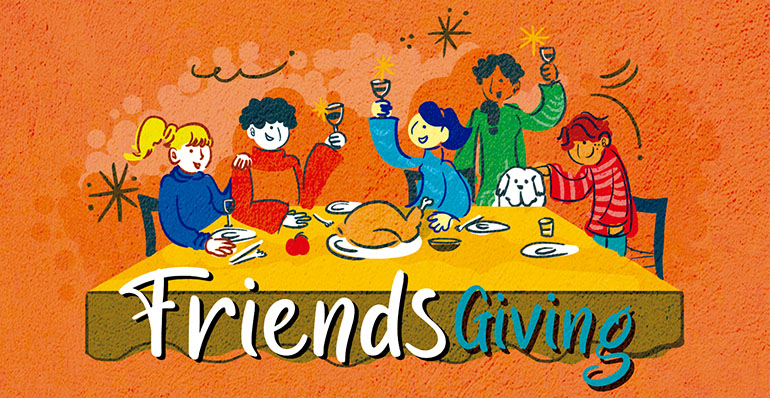Multicultural dishes to impress at your next Friendsgiving

Thanksgiving is a time when families get together for a large feast and share all the things they’re thankful for. But not everyone is able to travel home to spend this holiday with family. That’s where Friendsgiving comes in.
Similar to a potluck, Friendsgiving is an opportunity for friends to come over for Thanksgiving dinner and bring their own dish for their friends to try. With Canada being home to so many cultures, a Friendsgiving celebration here is sure to inspire a wide range of dishes from around the world.
I spoke to some of the friends in my life to get their ideas for the very best Friendsgiving recipes.
Andrei Caprar, a student at University of Waterloo shared his favourite Romanian dish.
“I grew up in a very Eastern European home where a quality community was a priority,” he explained. “So, whenever potlucks come around, my natural instincts are to go for something big that everyone would enjoy and find fulfilling, which usually is something called mici. These are Romanian sausages that are small and tend to be a mixture of ground beef, pork and lamb, mixed with a lot of spices, most importantly garlic. I have yet to find someone that doesn’t love them.”
Fanshawe grad, Lana Stryhun from Ukraine also suggested a traditional cultural dish for her Friendsgiving offering.
“I came here only two years ago and it was pretty hard to adjust to the culture,” Stryhun said. “As a Ukrainian, I would definitely bring borshch. Not only because it’s my personal preference, but also because it’s been recognized as a UNESCO Heritage Dish from Ukraine. I would like to share this dish and help people taste the culture.”
Manuela Espinosa is from Cali, Colombia and a recent graduate of Fanshawe College.
“I came to study in Canada. I think the dish that I would bring would be aborrajados. It is a Colombian dish, that is basically a cooked plantain with cheese inside and then fried. It’s a mix between sweet and salty and the cheese melts inside the plantain. This is my favourite dish and I would like to share it with my friends.”
Fanshawe student Manjot Singh offered a step-by-step guide to creating a dish from his home country for Friendsgiving.
“The idea of Friendsgiving kind of excites me a lot,” he said. “I am from the northern part of India. I am a Punjabi by culture and Punjab is home to some amazing dishes. The fact that the British colonized India because of the availability of spices is enough to attract anyone to amazing Indian food. Today, I am going to leave aside all the chillies and peppers and serve you something sweet. A sweet that can be eaten as a dessert, as a snack and, what I prefer, as a meal.”
Manjot’s “Gulab Jamun”
Ingredients:
- 1 cup milk powder
- 1/4 cup all-purpose flour
- 1/4 teaspoon baking powder
- 2 tablespoons ghee
- (clarified butter), melted
- 2 tablespoons milk (approximately)
- Oil or ghee for deep-frying
- 1 cup sugar
- 1 cup water
- 1/2 teaspoon rose water
- A pinch of cardamom powder
- A few saffron strands (optional)
- Chopped pistachios or almonds for garnish (optional)
Instructions:
- In a mixing bowl, combine the milk powder, all-purpose flour, and baking powder. Mix well.
- Add the melted ghee to the dry mixture and mix with your fingertips until the mixture becomes crumbly.
- Gradually add milk, a little at a time, and knead gently to form a soft dough. The dough should be slightly sticky. If it’s too dry, add a little more milk. Let the dough rest for 15 minutes.
- Meanwhile, in a deep saucepan or kadai, heat the oil or ghee over medium heat for deep-frying.
- While the oil is heating, prepare the sugar syrup. In a separate saucepan, combine the sugar and water. Place it over medium heat and stir until the sugar dissolves completely. Simmer the syrup for about 5 minutes until it slightly thickens. Add the rose water, cardamom powder, and saffron strands (if using), and let it simmer for another 2-3 minutes. Remove from heat and keep the syrup warm.
- Divide the dough into small portions and shape them into smooth, crack-free balls. Make sure there are no cracks, as they may cause the gulab jamuns to break while frying.
- Once the oil or ghee is hot, reduce the heat to low. Gently slide the prepared gulab jamun balls into the hot oil using a slotted spoon or strainer. Fry them on low heat, stirring occasionally, until they turn golden brown. This slow cooking ensures that the jamuns are cooked through and evenly browned. Remove them from the oil and drain them on a paper towel to remove excess oil.
- Transfer the fried gulab jamuns to the warm sugar syrup and let them soak for at least 30 minutes. The warm syrup helps the gulab jamuns absorb the flavours.
- Serve the gulab jamuns warm or at room temperature, garnished with chopped pistachios or almonds, if desired.
Friendsgiving is a creative way to bring all your friends together for a nice dinner and to have a fun night with them too. It’s a way to change things up this fall around Thanksgiving time and it could turn into a new tradition that you and your friends do every year.

